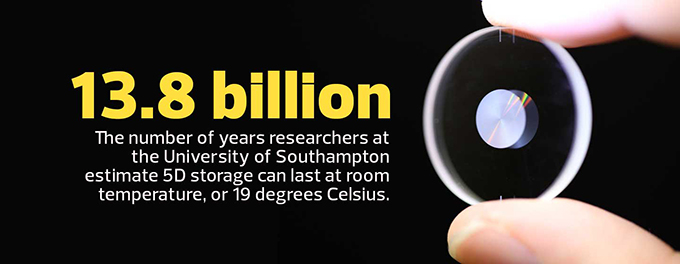Smashing Data Storage Records
Modern science has done it again, this time in the field of IT storage.
Scientists at the University of Southampton’s Optoelectronics Research Centre (ORC) used nanostructured glass to develop a storage media that can hold up to 360 terabytes of data at up to 1,000 degrees Celsius, and a virtually unlimited lifetime supply of data at room temperature.
As part of the research, the ORC saved major documents from human history in digital format, including the Universal Declaration of Human Rights (UDHR), Newton’s Opticks, the Magna Carta and the King James Bible.
Professor Peter Kazansky explains that the documents were recorded using ultrafast lasers that produce short and intense pulses of light.
Files are written in three layers of nonstructured dots separated by five micrometers, or five-millionths of a meter. The information is encoded in five dimensions: the media’s size and orientation in addition to the three-dimensional positions of the nanostructures.
Yesterday's Data ‘Will Not Be Forgotten’
“It is thrilling to think that we have created the technology to preserve documents and information and store it in space for future generations,” Kazansky says in a press statement released by the university. “This technology can secure the last evidence of our civilization: all we’ve learned will not be forgotten.” The researchers presented their findings at the International Society for Optical Engineering conference in San Francisco earlier this year.
They also presented a copy of the UDHR to the United Nations Educational, Scientific and Cultural Organization (UNESCO), a specialized agency of the United Nations, at the International Year of Light closing ceremony in Mexico last winter.

The Impact on Education
Kelly Calhoun, research director for education at Gartner, adds that while it’s unclear how long it will take to make this new storage viable and broadly available, the prospects for education are exciting.
“It’s pretty darn amazing,” she says. “We’ve had e-portfolios for a long time, but now with the prospect of 5D storage we can develop e-portfolios that last with people throughout their lifetimes,” she says.
Calhoun adds that educators and students are creating so much digital content and video today that there’s a real need for storage technology that can keep up with the pace of content creation.
“There are obvious applications for 5D storage, such as for museums, libraries and archives, but it’s exciting to think that as our students become lifelong learners there will be no limitations on what can be stored and recorded,” Calhoun says. “There’s also a great deal of potential for researchers in higher education to use the new storage technology on their research and development projects.”
The OCR researchers have indicated that they are meeting with industry partners to further develop and release commercial applications of the 5D technology.









